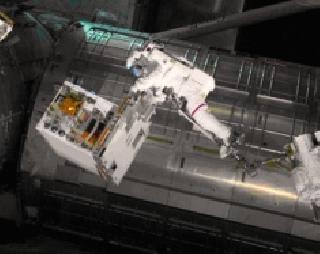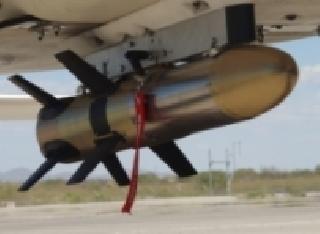
Spacewalker Mike Fossum carries the Robotic Refueling Mission module from space shuttle Atlantis to its temporary platform on the International Space Station on July 12, 2011. A robotic maneuver in September 2011 will transfer RRM to its permanent location on station�s ExPRESS Logistics Carrier-4. A NASA photo
WASHINGTON (BNS): A path breaking era would begin in space mission programmes when a new scientific module to refuel and repair satellites robotically in orbit is installed permanently outside the International Space Station (ISS) next month.
The NASA and Canadian Space Agency-designed Robotic Refueling Mission (RRM) – a washing machine-sized hardware that arrived at the ISS onboard space shuttle Atlantis, is set to be transferred to its permanent home on the space station’s ExPRESS Logistics Carrier-4 (ELC-4) in September.
The module will use the Canadian Space Agency-built Dexter robotic arm to repair and refuel existing satellites in orbit.
The ISS will provide command, telemetry and power support for the module through ELC-4 during the experiment’s two-year window of operations.
“The results of this two-year technology test bed are expected to reduce risks associated with satellite servicing as well as lay the foundation and encourage future robotic servicing missions.
“Such future missions could include the repair and repositioning of orbiting satellites,” NASA said.
After the transfer to ELC-4, mission operators will release the launch locks on the four RRM tools to be used at a later date by Dextre. This will be followed by a series of vision tasks, to develop machine vision algorithms against the harsh lighting on orbit verifying the RRM can see during future demonstrations.
The first set of refueling demonstration tasks are currently scheduled for January 2012 which will “verify that on-orbit satellite repairs can be performed with today’s technology,” the US space agency said.
“Robotic refueling and satellite servicing could extend the lifetimes of satellites, offering significant savings in delayed replacement costs,” said Frank Cepollina, Associate Director of the Satellite Servicing Capabilities Office (SSCO) at NASA’s Goddard Space Flight Center.
“Such servicing has the potential to allow human and robotic explorers to reach distant destinations more efficiently and effectively.”
The $22.6 million Robotic Refueling Mission consists of four unique tools, fittings and a tank of ethanol fuel which the Dextre robot will use to perform repairing and refueling tasks. RRM is expected to reduce risks and lay the foundation for future robotic servicing missions in microgravity.
 Previous Article
Previous Article












The Indian Air Force, in its flight trials evaluation report submitted before the Defence Ministry l..
view articleAn insight into the Medium Multi-Role Combat Aircraft competition...
view articleSky enthusiasts can now spot the International Space Station (ISS) commanded by Indian-American astr..
view article